5G Chipset Market Size
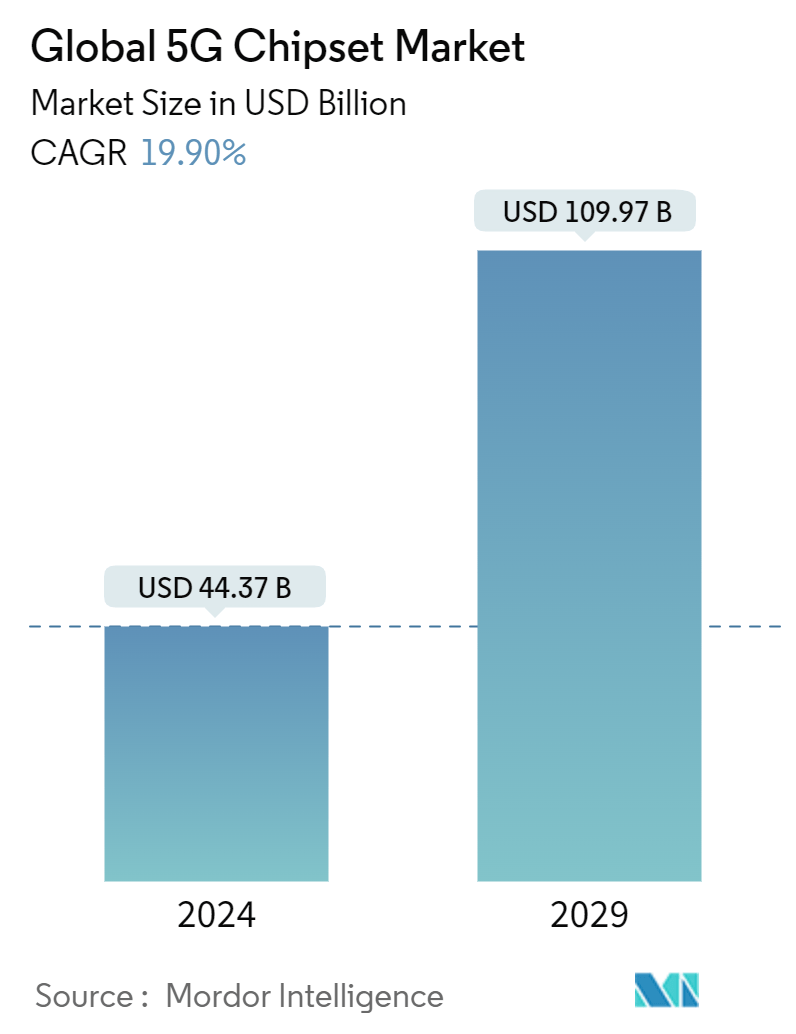
| Study Period | 2019 - 2029 |
| Market Size (2024) | USD 44.37 Billion |
| Market Size (2029) | USD 109.97 Billion |
| CAGR (2024 - 2029) | 19.90 % |
| Fastest Growing Market | Asia Pacific |
| Largest Market | North America |
Major Players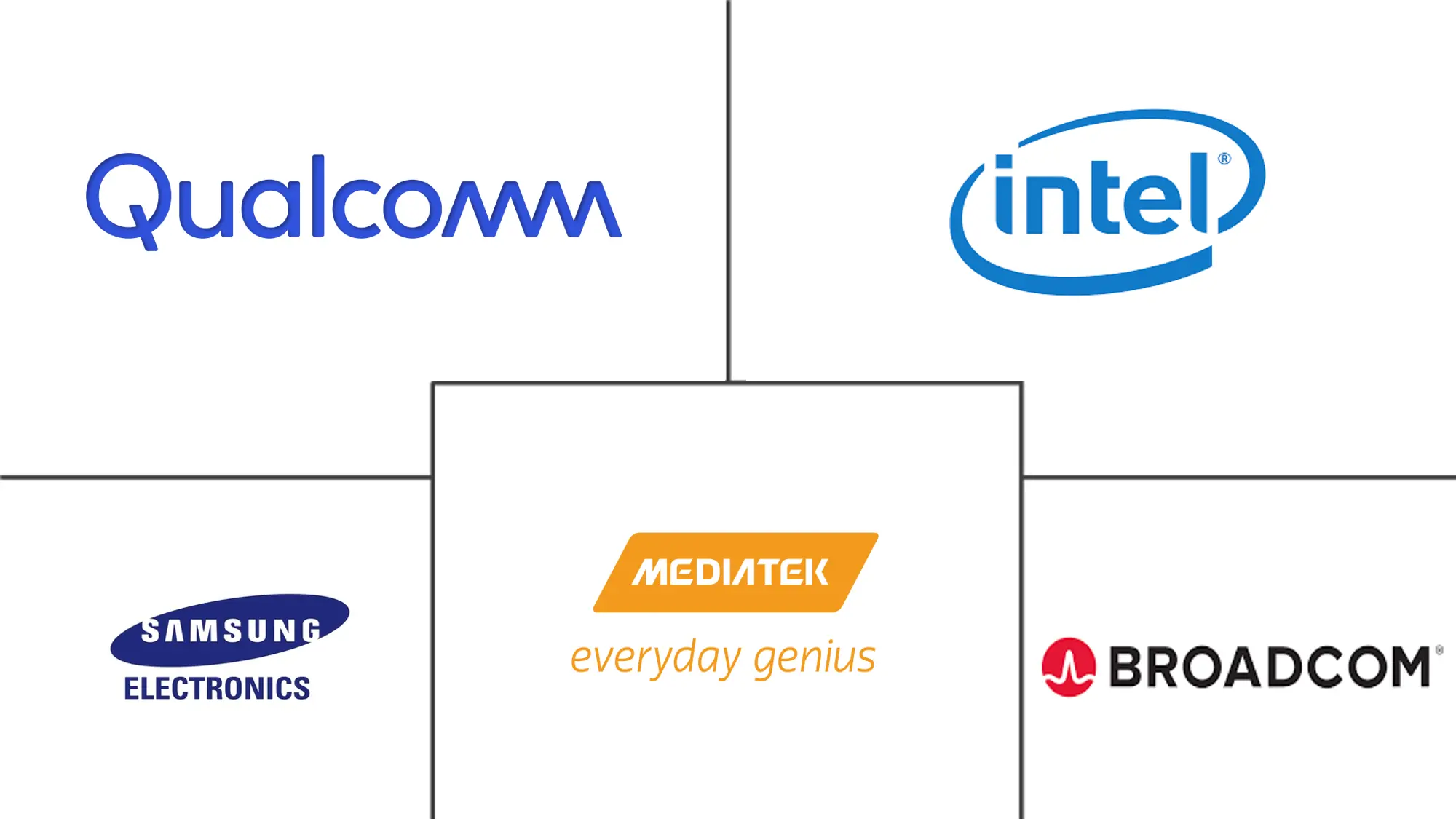
*Disclaimer: Major Players sorted in no particular order |
5G Chipset Market Analysis
The Global 5G Chipset Market size is estimated at USD 44.37 billion in 2024, and is expected to reach USD 109.97 billion by 2029, growing at a CAGR of 19.90% during the forecast period (2024-2029).
The 5G modem chipsets, in combination with service providers, largely serve and enhance the capabilities of three major applications - enhanced mobile broadband, ultra-reliable and low latency communications, and massive machine-type communications. The applications of this technology are expected to drive the demand for 5G chipsets during the forecast period.
- The 5G chipsets are expected to be a critical component of 5G networks, which will soon be rolled out at a massive scale for smartphone OEMs and telecom players. In order to provide ultra-high network speeds and data rates, major telecom service providers across the globe are upgrading their networks to 5G.
- The emergence of 5G is expected to expedite the use of connected devices in industries that are already pushing toward the fourth industrial revolution (Industry 4.0). Industry 4.0 is aiding cellular connectivity throughout the industry; the rise of IoT and machine-to-machine connections is also instrumental in driving market traction. Several smart city projects and initiatives are underway around the world, and it is expected that by 2025, there will be around 30 global smart cities, with half of these located in North America and Europe. These steps are supported by global investments, which, according to the OECD, are expected to total USD 1.8 trillion in urban infrastructure projects between 2010 and 2030. This is one of the major factors driving demand for 5G chipsets, owing primarily to their use in smart city connectivity applications.
- Multiple telecom operators are acquiring spectrums to increase their 5G connection coverage. For instance, in August 2022, In India's first 5G spectrum auction, Airtel paid Rs 43,084 crore for 19,800 MHz spectrum. In the past 20 years, spectrum bands 900 MHz, 2100 MHz, 1800 MHz, 3300 MHz, and 26 GHz have been acquired through auctions. It obtained a pan-India footprint in the 3.5 GHz and 26 GHz bands. According to the company, this is the ideal spectrum bank for the best 5G experience, with 100x capacity enhancement done strategically at the lowest cost.
- During the pandemic, the WFH setting was prepared for the extra technological benefits of 5G: in the Global Workplace Analytics (2020) survey, more than 80% of respondents stated that they had the technical skills and knowledge required for WFH, as well as easy and reliable access to company networks (presumably by both fixed-line and mobile means).
- 3GPP has specified that 5G should offer voice or video communication services based on the IMS, i.e., the IMS must be deployed for 5G-to-3G SRVCC in 3GPP Release 16 or VoNR, EPS FB, VoeLTE, and RAT FB in 3GPP Release 15. Hence such upgrades are expected to increase the infrastructure cost, thereby challenging the market's growth. While every architecture has specific challenges, all of them need network readiness of the IP Multimedia Subsystem (IMS) within the carrier's network.
5G Chipset Market Trends
Industrial Automation to Account for a Significant Share
- According to Capgemini, three out of every ten automotive plants have become smart in the last 18-24 months. Furthermore, 80% of automakers believe 5G will be critical to their digital transformation over the next five years. For instance, Ericsson and Audi are conducting field trials, such as wirelessly connected production robots building a car body at the latter company's production lab in Gaimersheim, Germany, using simulated processes similar to those used at its headquarters in Ingolstadt.
- The emphasis on smart manufacturing practices is a significant trend influencing the market. According to IBEF data, the Government of India has set an ambitious target of increasing manufacturing output contribution to GDP to 25% by 2025, up from 16%. The Smart Advanced Manufacturing and Rapid Transformation Hub (SAMARTH) Udyog Bharat 4.0 initiative aims to raise awareness of Industry 4.0 in the Indian manufacturing industry and assist stakeholders in addressing smart manufacturing challenges.
- The Industry 4.0 revolution, or industrial internet of things (IIOT) is making a dent in the automotive, manufacturing, warehousing, and logistics sectors by leveraging smart machines and real-time analytics on data produced by dumb machines. However, automation created several challenges in these sectors. Expected operational improvements proved hard to match due to a lack of integration with the required hardware. For instance, automation contributes to just 1% of manufacturing GDP in India, compared to around 5% in developed countries. This stems from a gap in suitable technology available for adoption. Further, According to GSMA By 2025 the total number of consumer and industrial Internet of Things (IoT) connections in North America is forecast to grow to 5.4 billion
- 5G has garnered significant interest considering the promised benefits within industrial environments. Since 3GPP's Release 16, key capabilities for enterprise 5G (such as 99.999% network availability and reliability, sub-10 milliseconds latencies, and Internet support for time-sensitive networking) has attracted ,industrial players for digitization in the context of Industry 4.0.
- For example, ABB and Ericsson collaborated to realize Thailand's Industry 4.0 ambition and facilitate future flexible production with automation systems and wireless communications. The focus areas include ABB's Robotics & Discrete Automation, Industrial Automation, and Motion business areas and ABB Ability TM Platform Services. The collaboration would cover 5 G-enabled andAugmented Reality Lenses for remote commissioning in manufacturing environments G-enabledand global NB-IoT connected motors and drives through Ericsson Communication Service Provider partners and its IoT-Accelerator platform.
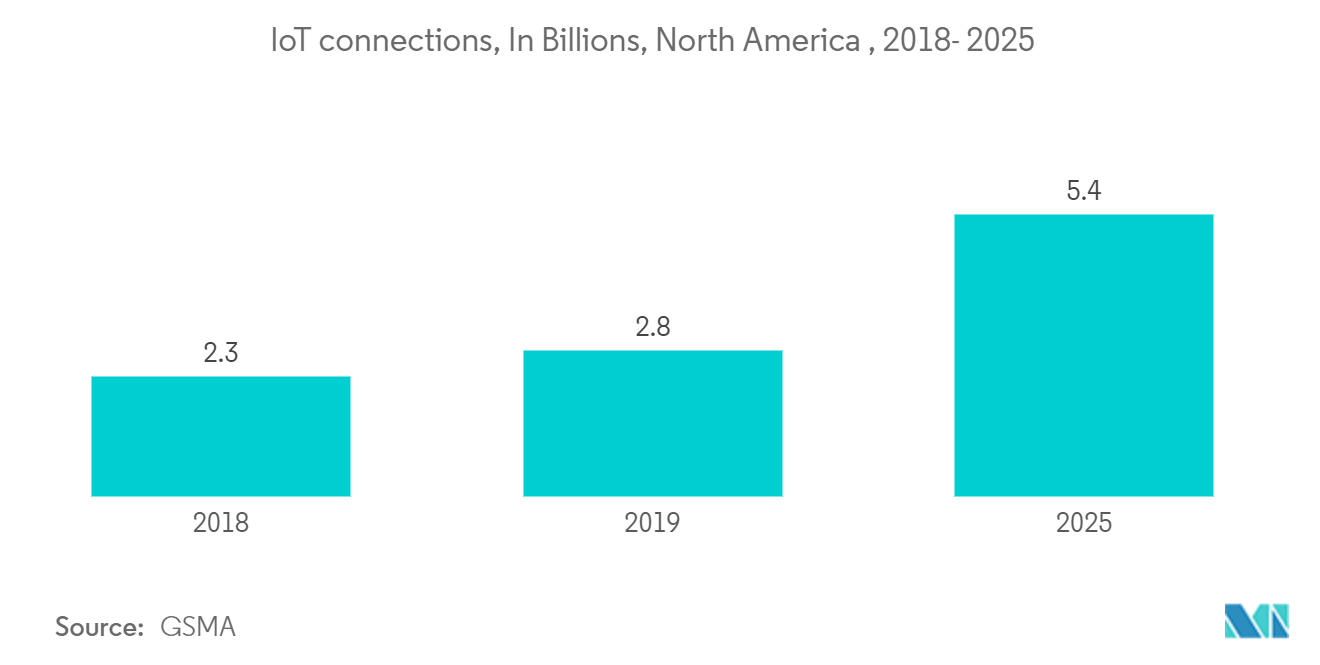
North America to Account for the Largest Share
North America is one of the most important market growth regions. The United States has contributed the majority of the region's market share. The demand for IoT, M2M communications, mobile broadband, and other emerging applications is driving the increase.
In North America, 5G connections will represent more than half of all mobile connections, according to GSMA Intelligence's 'Mobile Economy North America 2020' report. By 2025, 51% of the region's 426 million mobile connections will be on 5G networks. According to the report, the region will have 340 million mobile subscribers by 2025.
Furthermore, according to Cisco Annual Internet Report, the average smartphone connection speed in the United States will be 81.1 Mbps by 2023, up from 19.2 Mbps in 2018, 4.2-fold growth (33% CAGR). Alongside 5G rollouts, operators are also pursuing ambitious network transformation strategies. Moreover, 18 global telecom and consumer device makers partnered with US-based Qualcomm for their 5G chipset.
New safety-sensitive applications, collectively known as V2X or Vehicle-to-Everything, will be made possible by 5G's enhanced throughput, dependability, availability, and decreased latency. To facilitate the convergence of various apps for urban, suburban, and highway driving circumstances, 5G Cellular V2X (C-V2X) offers a common wireless network.
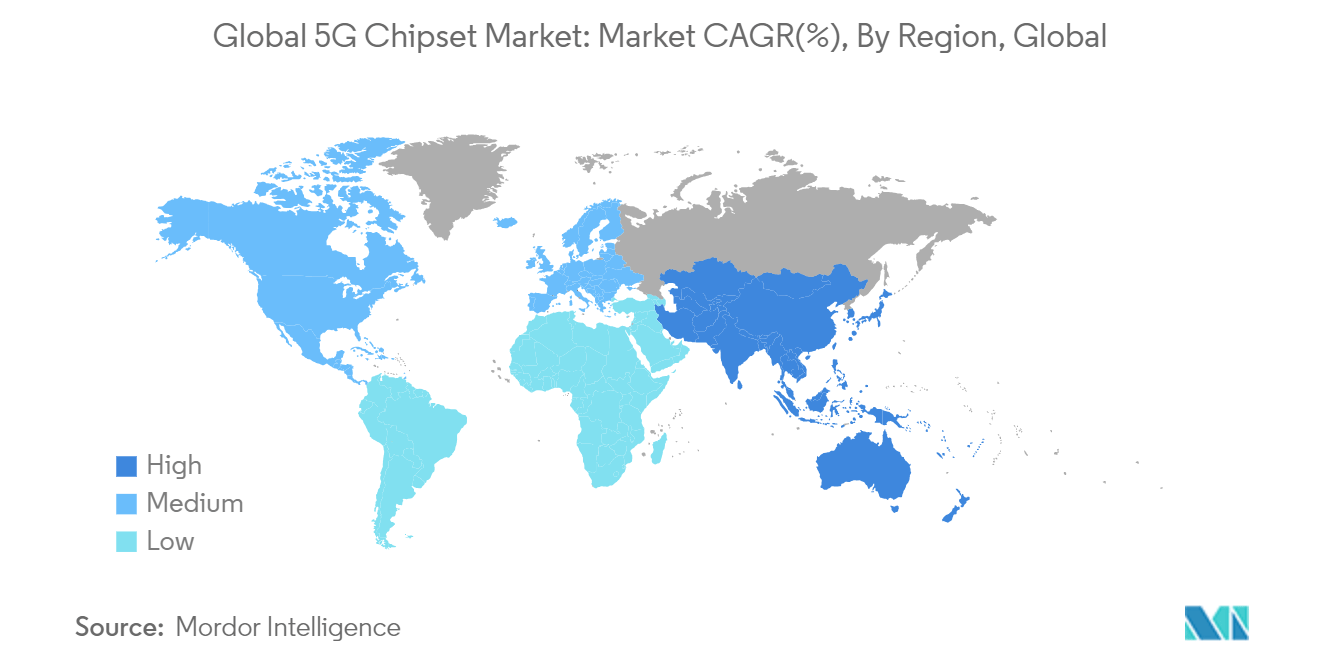
5G Chipset Industry Overview
The 5G chipset market is semi-consolidated, with many regional and global players. Innovation drives the market in product offerings, and each vendor invests in innovation.
- Nov 2023 - MediaTek launched Dimensity 8300 5G chipset with genAI capabilities. The chipset is based on TSMC’s second-generation 4nm process and has an octa-core CPU comprising four Arm Cortex-A715 cores and four Cortex-A510 cores built on Arm’s v9 CPU architecture. It is paired with the Mali-G615 MC6 GPU. The Dimensity 8300 unlocks new possibilities for the premium smartphone segment, offering users in-hand AI, hyper-realistic entertainment opportunities, and seamless connectivity.
- November 2023 - Viettel High Tech developed its own 5G chipset. The 5G DFE (digital front end) chip can perform 1 quadrillion calculations per second.
5G Chipset Market Leaders
-
Intel Corporation
-
Qualcomm Technologies Inc.
-
Broadcom Inc.
-
Samsung Electronics Co. Ltd
-
MediaTek Inc.
*Disclaimer: Major Players sorted in no particular order
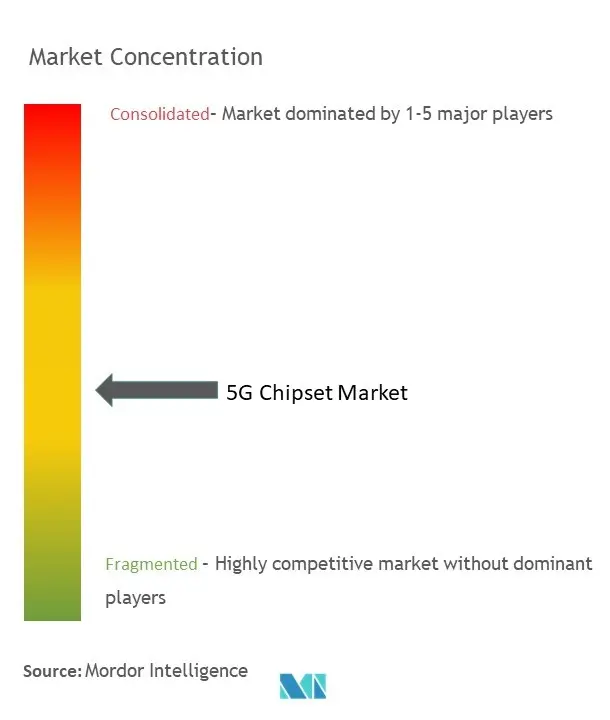
5G Chipset Market News
- Sept 2023 - Qualcomm announced an extension of its partnership with Apple to supply 5G chips for the iPhone until at least 2026. This deal will help Apple to fortify its supply chain operations globally.
- July 2023 - Intel partnered strategically with Ericsson to manufacture custom 5G system-on-chips (SoCs) for Ericsson's telecom networking equipment. Intel will manufacture custom 5G SoCs for Ericsson using the “18A” process technology. This is a significant milestone with Ericsson to partner broadly on their next-generation optimized 5G infrastructure.
- May 2023 - Mediatek, a Taiwanese fabless chipmaker, unveiled its new Dimensity 9200+ 5G chipset for premium smartphones. Smartphones powered by the MediaTek Dimensity 9200+ will be available beginning in May 2023, according to Mediatek. The TSMC 4nm-class second-generation process underpins the Dimensity 9200+ chipset. It combines the Arm Immortalis-G715 GPU with one ultra-core Arm Cortex-X3 processor running at up to 3.35GHz, three Arm Cortex-A715 super-cores running at up to 3.0GHz, and four Arm Cortex-A510 efficiency cores running at 2.0GHz.
- June 2022 - To develop chipsets for Ligado's5G mobile satellite network for the Internet of Things (IoT), LigadoNetworks has entered a relationship with Sony Semiconductor Israel. This is a key development for rolling out advanced connectivity services across North America. In a statement, Ligadosaid that joining with Sony puts it "one step closer" to giving enterprise customers standalone satellite and satellite and terrestrial connectivity.
5G Chipset Market Report - Table of Contents
1. INTRODUCTION
- 1.1 Study Assumptions and Market Definition
- 1.2 Scope of the Study
2. RESEARCH METHODOLOGY
3. EXECUTIVE SUMMARY
4. MARKET INSIGHTS
- 4.1 Market Overview
- 4.2 Industry Value Chain Analysis
-
4.3 Industry Attractiveness - Porter's Five Forces Analysis
- 4.3.1 Bargaining Power of Suppliers
- 4.3.2 Bargaining Power of Buyers
- 4.3.3 Threat of New Entrants
- 4.3.4 Threat of Substitutes
- 4.3.5 Intensity of Competitive Rivalry
- 4.4 Technology Snapshot
- 4.5 Impact of Macro Economic trends on the Industry
5. MARKET DYNAMICS
-
5.1 Market Drivers
- 5.1.1 Increasing Demand for High-speed Internet and Broad Network Coverage with Reduced Latency and Power Consumption
- 5.1.2 Growing Machine-to-machine/IoT Connections
- 5.1.3 Increase in Demand for Mobile Data Services
-
5.2 Market Restraints
- 5.2.1 Fragmented Spectrum Allocation
6. MARKET SEGMENTATION
-
6.1 By Chipset Type
- 6.1.1 Application-specific Integrated Circuits (ASIC)
- 6.1.2 Radio Frequency Integrated Circuit (RFIC)
- 6.1.3 Millimeter Wave Technology Chips
- 6.1.4 Field-programmable Gate Array (FPGA)
-
6.2 By Operational Frequency
- 6.2.1 Sub-6 GHz
- 6.2.2 Between 26 and 39 GHz
- 6.2.3 Above 39 GHz
-
6.3 By End User
- 6.3.1 Consumer Electronics
- 6.3.2 Industrial Automation
- 6.3.3 Automotive and Transportation
- 6.3.4 Energy and Utilities
- 6.3.5 Healthcare
- 6.3.6 Retail
- 6.3.7 Other End Users
-
6.4 By Geography
- 6.4.1 North America
- 6.4.2 Europe
- 6.4.3 Asia Pacific
- 6.4.4 Latin America
- 6.4.5 Middle East and Africa
7. COMPETITIVE LANDSCAPE
-
7.1 Company Profiles*
- 7.1.1 MediaTek Inc.
- 7.1.2 Intel Corporation
- 7.1.3 Samsung Electronics Co. Ltd
- 7.1.4 Xilinx Inc.
- 7.1.5 Nokia Corporation
- 7.1.6 Broadcom Inc.
- 7.1.7 Infineon Technologies AG
- 7.1.8 Huawei Technologies Co. Ltd
- 7.1.9 Renesas Electronics Corporation
- 7.1.10 Anokiwave Inc.
- 7.1.11 Qorvo Inc.
- 7.1.12 NXP Semiconductors NV
- 7.1.13 Cavium Inc.
- 7.1.14 Analog Devices Inc.
- 7.1.15 Texas Instruments Inc.
8. INVESTMENT ANALYSIS
9. FUTURE OF THE MARKET
** Subject To Availablity5G Chipset Industry Segmentation
5G chipsets enable 5G packet transmission on smartphones, portable hotspots, IoT devices, and, increasingly, notebook PCs with mobile network capabilities. 5G mobile devices will combine familiar sub-6GHz bands with new MIMO antenna systems and high-frequency millimeter-wave (mmWave) bands with highly focused beam-steering.
The global 5g chipset market is segmented by chipset type (application-specific integrated circuits (ASIC), radio frequency integrated circuit (RFIC), millimeter wave technology chips, field-programmable gate array (FPGA)), operational frequency (sub-6 GHZ, between 26 and 39 GHz, and above 39 GHz), end user (consumer electronics, industrial automation, automotive and transportation, energy and utilities, healthcare, and retail), and geography(North America, Europe, Asia-Pacific, Middle-East and Africa and Latin America). The report offers the market size in value terms in (USD) for all the segments mentioned above.
| By Chipset Type | Application-specific Integrated Circuits (ASIC) |
| Radio Frequency Integrated Circuit (RFIC) | |
| Millimeter Wave Technology Chips | |
| Field-programmable Gate Array (FPGA) | |
| By Operational Frequency | Sub-6 GHz |
| Between 26 and 39 GHz | |
| Above 39 GHz | |
| By End User | Consumer Electronics |
| Industrial Automation | |
| Automotive and Transportation | |
| Energy and Utilities | |
| Healthcare | |
| Retail | |
| Other End Users | |
| By Geography | North America |
| Europe | |
| Asia Pacific | |
| Latin America | |
| Middle East and Africa |
5G Chipset Market Research FAQs
How big is the Global 5G Chipset Market?
The Global 5G Chipset Market size is expected to reach USD 44.37 billion in 2024 and grow at a CAGR of 19.90% to reach USD 109.97 billion by 2029.
What is the current Global 5G Chipset Market size?
In 2024, the Global 5G Chipset Market size is expected to reach USD 44.37 billion.
Who are the key players in Global 5G Chipset Market?
Intel Corporation, Qualcomm Technologies Inc., Broadcom Inc., Samsung Electronics Co. Ltd and MediaTek Inc. are the major companies operating in the Global 5G Chipset Market.
Which is the fastest growing region in Global 5G Chipset Market?
Asia Pacific is estimated to grow at the highest CAGR over the forecast period (2024-2029).
Which region has the biggest share in Global 5G Chipset Market?
In 2024, the North America accounts for the largest market share in Global 5G Chipset Market.
What years does this Global 5G Chipset Market cover, and what was the market size in 2023?
In 2023, the Global 5G Chipset Market size was estimated at USD 35.54 billion. The report covers the Global 5G Chipset Market historical market size for years: 2019, 2020, 2021, 2022 and 2023. The report also forecasts the Global 5G Chipset Market size for years: 2024, 2025, 2026, 2027, 2028 and 2029.
5G Chipset Industry Report
Statistics for the 2024 5G Chipset market share, size and revenue growth rate, created by Mordor Intelligence™ Industry Reports. 5G Chipset analysis includes a market forecast outlook to 2029 and historical overview. Get a sample of this industry analysis as a free report PDF download.



